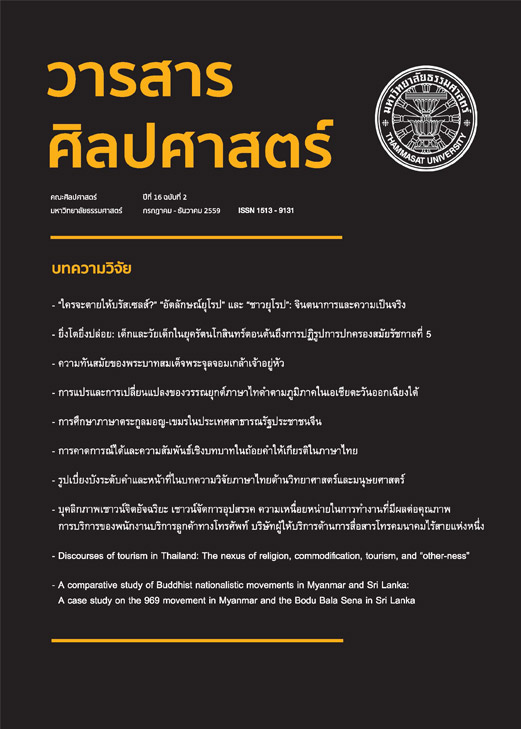Discourses of tourism in Thailand: The nexus of religion, commodification, tourism, and “other-ness”
Main Article Content
บทคัดย่อ
This paper reports on an on-going study of the discourse(s) of tourism in Thailand, focusing upon the linguistic landscapes present heritage sites in Thailand. The study focuses upon the geosemiotic nature of signage in Thai heritage sites specifically drawing attention to interactivity, prayer, ephemerality, ethnicities, and a discussion of the notion of boundary objects in Thai heritage sites. The discourses in place that makeup the tourist landscape of Thailand comprise a variety of complex semiotic aggregates: signs indexing a foreign other, signs regulating tourist behavior, and signs that request donations. Of particular interest is the makeup of the linguistic landscape within Buddhist temples where tourists (both Asian and Farang) are asked to make donations. Another issue immanent in Thai tourism is how elements of everyday Thai Buddhist religious practice (attending temple, prayer, making merit) become commodified in the tourist gaze.
วิจัยฉบับนี้นำเสนอการศึกษาระบบข้อความที่ใช้ในบริบทการท่องเที่ยวในประเทศไทย โดยมุ่งเน้น ที่การศึกษาภูมิทัศนภาษาศาสตร์ตามสถานที่ท่องเที่ยวทางวัฒนธรรม วิจัยฉบับนี้เน้นการศึกษาภูมิสัญศาสตร์ของป้ายข้อความในสถานที่ท่องเที่ยวทางวัฒนธรรมไทย โดยเฉพาะป้ายดึงความสนใจให้เกิดการกระทำต่าง ๆ บทสวดมนต์ ป้ายหมุนเวียนชั่วคราว ป้ายเจาะจงการแจ้งบอกเฉพาะกลุ่มเชื้อชาติ และการอภิปรายถึงการใช้ป้ายข้อความในบริบทต่าง ๆ ระบบข้อความที่ก่อให้เกิดภูมิทัศนภาษาศาสตร์ในประเทศไทยดังกล่าวประกอบไปด้วยกลุ่มความหลากหลายทางสัญศาสตร์: ป้ายคำสั่งผู้ที่เป็นชาวต่างชาติ ป้ายแจ้งระเบียบสำหรับชาวต่างชาติ และป้ายขอความอนุเคราะห์บริจาคทรัพย์ สิ่งที่วิจัยฉบับนี้ให้ความสนใจเป็นอย่างมากคือภูมิทัศนภาษาศาสตร์ที่เกิดขึ้นในวัดไทยซึ่งเป็นสถานที่ที่นักท่องเที่ยว (ทั้งชาวไทยและชาวต่างประเทศ) ได้รับการร้องขอให้บริจาคทรัพย์ อีกประเด็นที่อยู่ภายในขอบเขตของการศึกษาการท่องเที่ยวไทยคือการประกอบพุทธศาสนกิจของไทยในชีวิตประจำวัน (การเข้าวัด สวดมนต์ ทำบุญ) ได้เข้ามาอยู่ในความสนใจของนักท่องเที่ยวได้อย่างไร


